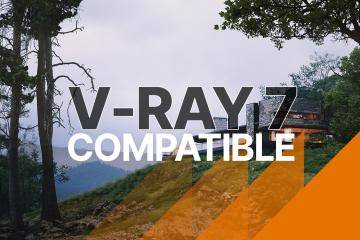Noticias
Lea los últimos desarrollos de ITOOSOFT

Anyone with even a passing interest in Architecture will know the name Frank Lloyd Wright. During his 70 year creative period, 532 of Wright’s designs were built and his Fallingwater project has become one of the best known and most recognizable examples of American architecture.
Less well known are Wright’s unbuilt projects. An enormous number, over 600 in fact, were never realized, but now, thanks to the visualization skills of Spanish Architect David Romero, we can get a vivid sense of how these buildings might have looked.
David Romero’s project Hooked on the Past, focuses on the re-creation of the unbuilt architecture of yesterday, a fascinating field of work that is often overlooked in the world of architectural visualization. The Hooked on the Past project has so far focused on the work of Frank Lloyd Wright and two recent projects serve as great examples of David’s typical workflow.
Gordon Strong Automobile Objective

The recreation of the Gordon Strong Automobile Objective was commissioned by the Frank Lloyd Wright Foundation for its quarterly magazine and David was given the full support and access to the resources of the Foundation. “Not only was I able to consult all the drawings that Wright did for this design,” he tells us, “but I was also able to obtain the invaluable assistance of people linked to the Foundation who helped me unravel the different relevant historical details of this project.”
Using Railclone for the building
According to David, RailClone forms an essential part of his modelling workflow: “since the building contains a helicoidal ramp for the use of vehicles, but it also contained a restaurant. Modelling both these elements would not have been possible for me without the existence of this fantastic software.”
One of the reasons RailClone can help artists like David is its ability to make large sophisticated procedural objects from relatively simple and easy to model repeated elements. The Ramp in the Gordon Strong building is a good example. The whole object is created from the 3 modular pieces shown below. These are much easier and faster to model that then the entire building, and it only takes a little forward planning and understanding of RailClone’s approach to modelling to save a lot of time.
You might wonder how these 3 simple pieces become a whole façade? It’s actually very simple. RailClone is able to repeat and distribute geometry along splines, and deform it to follow the curvature of the path. By arraying the pieces along the helicoidal spline shown below it was possible to make the whole ramp section from just a few pieces. Best of all, because RailClone is a procedural object, it’s easy to edit. By tweaking or substituting the original 3 segments, the whole building can be quickly iterated.
To control where the 3 source pieces were distributed along the spline, David used Material ID numbers assigned to the spline’s segments. By using RailClone’s Conditional operator it was then possible to target these parts of the spline with different geometry simply by testing to see if the segment was currently on the spline in an area with a correlating material ID. Compared to the rat’s nest of nodes seen in some procedural tools, the final graph shown below is refreshingly simple and quite easy to read, even if you are new to the plugin. You can see the Conditional operators connected in series to test for multiple IDs:
The final geometry for the building’s shell is shown below in the viewport and a render.

RailClone has many uses, not limited to creating a single contiguous mesh. It’s equally well suited to advanced spline-based placement of single objects, like furniture inside buildings. In this project, David used RailClone to place all the tables and chairs inside the planetarium.

Creating the site context with Forest Pack
Forest Pack, as the name suggests, is most commonly associated with scattering plants, rocks and trees to create rich renders of natural environments.
When rendering the landscape that surrounds an architectural project, “where is it located ?” is the first obvious question. The original site for the Gordon Strong Automobile Objective was in a beautiful natural landscape in Maryland.
In addition to “where?” though, when rendering landscapes there is also the question of “When?”. According to David “the mountain offers stunning views all year round, but in Fall, the vegetation has incredible colours, so I decided to show the environment at that time of the year.”
To get the fall look, Forest Colour was used to randomise between yellow and browning leaves on all the trees. If you’d like to learn more about that technique there’s a useful tutorial called Autumn Park.
How many trees? Not as many as you’d think. By randomizing the translation, rotation and scale of plant models it is possible to disguise the fact that you are using just a few variations with no obvious visible repetition. In fact, there are only 3 trees used in the entire scene and just a handful of smaller plants, bushes rocks, and other ground cover as shown in the image below.

Using several Forest Pack objects to scatter these objects in successive layers on the terrain, David was able to create all the vegetation for the scene in a way that would render efficiently and was easy to update.

If you’d like to know more about this project, there is an extensive article in the magazine that covers the process of creating the images in more detail.
E.A. Smith House

The second Project created with the help of Forest Pack and RailClone is Frank Lloyd Wright’s E.A. Smith House. The cabin was planned to be built in the beautiful Piedmont Pines, Oakland.
“These images have been made using my usual workflow,” David tells us, “Modeling in Autocad, lighting, cameras and vegetation in 3DS Max, Rendering with V-Ray and finishing touches in Photoshop.
Once again Forest Pack and RailClone were was used extensively for the project. “RailClone was key in the realization of this model since all the parts of the building that use wood planks use the plugin, and of course Forest Pack was invaluable for the creation of the trees and the shrubs.”

Moving to VR
More recently David collaborated with Unreal Enterprise and HP to convert an old scene of Frank Lloyd Wright’s Trinity Chapel to virtual reality. Using the Datasmith tool that comes as part of Unreal Studio and supports Forest Pack and RailClone, David was able to convert his scene to an interactive VR experience that included audio, voiceover, different lighting possibilities and pop up information points to explain more about the design. If you want to try the VR experience for yourself, it can be downloaded from the Unreal website or you watch the following video to see a prerecorded demo.
We’d like to thank David for sharing his fascinating project with us. To see more of his work, please visit his website Hooked on the Past
If you’re interested in being showcased in an article or you’d like to share images in our gallery, please feel free to email submission@itoosoft.com.







